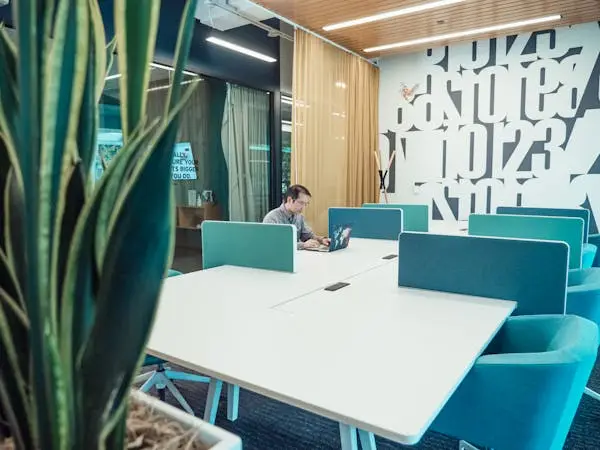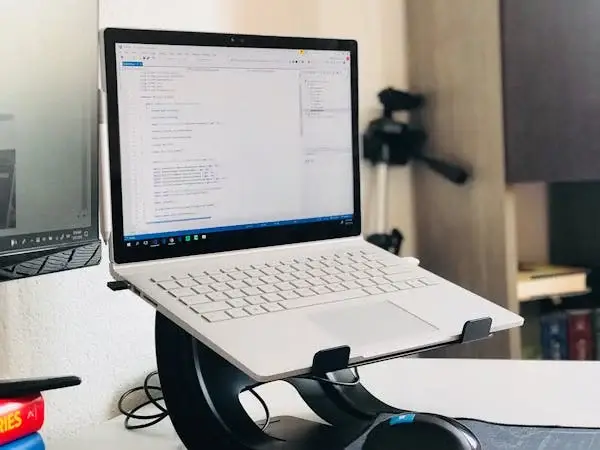
Table of Contents
ToggleRemote Work Productivity Hacks with Ergonomics: 10 Proven Strategies for a Healthier and More Efficient Home Office
Faraway work has shifted from a brief option to a permanent mode of operation for many specialists worldwide.
While remote working provides flexibility, independence, and improved work-life balance, it also comes with several distractions that can threaten productivity. Striking a balance between output and comfort remains tricky. But you need to use remote work hacks with ergonomics to boost productivity and overcome these barriers. Notably, this combination maximizes productivity while keeping your workspace comfortable and efficiently enabled.
Combining these innovative productivity strategies with good ergonomics will optimize your home office and help your body do the work so you can focus on the task at hand. Remote work productivity hacks with ergonomics for your problem With long working hours on the computer, you can have terrible postures, irritation in your eyes, or get distracted by various small things — remote work productivity hacks with ergonomics can help overcome these problems efficiently. These strategies help you get better physically and create mental clarity and long-term productivity.
This article is all about 10 tried-and-tested remote work productivity hacks, with ergonomics in mind — all of which will help you optimize your work area further, cut the distractions and help you avoid everyday aches and pains caused by being at your desk for too long. These tips will help you create a comfortable space that promotes productivity, from charting the most ergonomic furniture to maximizing your time through your schedule.
When it comes to working from home successfully over the long term, the ergonomics of your setup are non-negotiable. By combining remote work productivity hacks and ergonomics, you can set up a space that minimizes physical strain and discomfort and continues to support your productivity into the future. If you’re setting up a workspace for the first time or reassessing your current work zone, use these strategies to build a more comfortable and productive workspace.
Remote Work: An Introduction and Its Challenges
Remote work is not a trend — it has become a permanent feature of life for millions of professionals worldwide. With more companies adopting flexible work policies, the need for practical and comfortable remote workspaces has grown. Despite the advantages of remote work—the lack of a daily commute, greater control over your schedule and the ability to create a workspace that suits you—this adjustment poses some unique challenges.
It can be challenging, especially as the line between “work” and “home” blurs. Distractions from family, pets, or household chores can break your workflow, making it harder to stay focused. Moreover, many home-based professionals find it very hard to remain focused and motivated without the physical atmosphere of an office.
That’s when remote work productivity hacks with ergonomics come in. Designing a workspace that suits your body can help you stay focused by minimizing physical discomfort or fatigue distractions. Read on to learn how to combine remote work productivity hacks with ergonomics to address these challenges and create space that supports comfort and focus, from investing in ergonomic furniture to utilizing time management hacks like the Pomodoro method. Tackling these challenges enables greater productivity and the ability to develop a healthier, more sustainable homework regimen.
The Shift to Remote Work
The shift to remote working is now a fundamental change in how we do our jobs, changing what was once a rare luxury into the new normal for millions of workers and industries. Many benefits of working from home include drastically reduced commute time, a better work-life balance, and the ability to build a personalized workspace. For those who leapt, it’s been life-changing — they have more control and flexibility over their work schedules.
Yet, if the benefits of remote work are clear, the evolution also poses a range of challenges. For many remote workers, it is much harder to replicate the same structure they experienced when working in an office. No personal-life and professional-life boundaries could cause burnout, and no physical working environment with coworkers may trigger isolation or communication breakdown.
Investing in an ergonomic chair, appropriate desk height, and regularly getting up from your chair — remote work productivity hacks will cover that physical health part, and getting the work done on time. Not only should these changes work to your comfort, but they also serve to get a pattern going that works towards productivity, focus, and well-being over the long run.
Overcoming Remote Work Productivity Barriers
Remote work can offer flexibility and comfort, but it can also lead to various productivity challenges that can impact performance dramatically. Distractions are one of the most common challenges for remote workers. Things like family, pets, or household chores often distract from the work, making concentrating difficult. In a more casual home environment, these interruptions can quickly disrupt the workflow and push you back on deadlines.
A significant barrier that the absence of a work-from-home policy creates is the ambiguity between personal time and work hours. While when your home is your office, it’s relatively simple to end up working until late evening or reading emails over the weekends — the cause of procrastination and disorganization. The absence of demarcation between work and recreation time leads to mental fatigue, making you feel too tired to be productive.
A poorly configured workspace can compound these issues. Long hours of sitting in an uncomfortable pose or working on a messy desk can distract you from focusing, and your enthusiasm can dwindle. However, we can overcome those hindrances by combining remote work productivity hacks and ergonomics. A dedicated, ergonomic workspace can help limit distractions, maintain optimal posture, and reduce physical stress and fatigue.
Simple changes like using an ergonomic chair, adjusting the height of your desk, and arranging your office are some ways that office design can drastically enhance how productive you are during work hours. Whether your workplace is your sunny balcony or a sleepy bedroom, these ergonomics-focused productivity hacks for the three new D words—distance, desk and discipline—will help you raise your comfort level and create a working environment that sustains focus, routine and minimum procrastination.
Understanding Ergonomics For Remote Work
While many remote workers stress time management and task prioritization, one of the key aspects that is often neglected is ergonomics. Ergonomics is setting up your workspace to fit your body and minimize stress while improving comfort. An ergonomic setup is also crucial for your physical and mental health when working from home, as you may spend prolonged hours at your desk. Without it, the pain and discomfort caused by poor posture, repetitive movements, and lack of support can adversely affect your health and productivity.
Contact Us A good ergonomic workspace can help reduce common problems like back pain, wrist strain and neck stiffness. Aside from being painful, physical ailments develop mental fatigue and make it comfortable to focus on things. This is where remote work tips with ergonomics work. By incorporating ergonomic principles into your design, you can create a workspace that minimizes the risk of injury while maximizing comfort and efficiency. Let’s say you have an ergonomic chair, a height-adjustable desk that helps you support your lower back, and a computer monitor positioned at eye level.
Furthermore, ergonomics is not only about the furniture choices you make. Integrating remote work productivity hacks with ergonomics also involves taking regular breaks, exercising good posture and organizing your workspace to keep clutter and distractions to a minimum. Though small, these changes make a significant difference and are there to keep you invigorated, avoid burnout and keep up or boost productivity while working long hours at home.

Effects of Bad Ergonomics on Health and Productivity
If you persona non grata your back while you’re sequestered in your home office by slouching at a desk or using a chair that doesn’t provide proper lumbar support, the ramifications can harm your health and productivity. In-home offices, where convenience often trumps ergonomics, poor posture and inadequate workstation setups are standard. These misalignments may lead to some immediate physical discomfort, like neck, back, and wrist pain, which can be distracting in and of themselves and may affect your ability to concentrate on the task.
The long-term strain of inadequate ergonomic practices can result in more severe and long-term health problems. By improperly setting up a workstation, one can develop long-term conditions such as repetitive stress injuries (RSI), carpal tunnel syndrome, and tendonitis. These conditions hurt and can also restrict your range of motion and your mechanical effectiveness in performing the tasks the body is meant to do, further cutting down your productivity.
This is where ergonomics meets productivity hacks for remote work. These problems can arise; however, in the first place, you can avoid them using simple ergonomic fixes in your workspace. For example, you can reduce strain on your neck, back, and wrists by adjusting your chair to ensure it has good lumbar support, setting your desk at an appropriate height, and placing your computer screen at eye level. Also, using Proper tools such as keyboard and mouse pads that offer a neutral wrist position can help ease discomfort and prevent injuries like Carpal tunnel syndrome.
Benefiting from remote work productivity hacks with the one through two-Es is not only to prevent damage and pain — it is to encourage an environment of work that promotes your long-term health and supports your ability to work fast. Big picture, these minor tweaks can help you avoid mental fatigue, clarify your focus, and improve your productivity, enabling you to work comfortably and sustainably from home.
Those health issues may also impact your work productivity. He had pain and discomfort at first, which made him unable to focus, slowed his work pace, forced him to take frequent breaks, etc, he said.
Ergonomics Is A Secret Productivity Hack
If your computing device is adjusted ergonomically, you’ll position a way to minimise stress for your frame, which means much less distraction due to physical pain. Whilst your frame has the right guide, recognising your paintings and staying attentive during the day will be much less complicated. A secure chair with a lumbar aid, a table that promotes good posture, and a monitor at the eye stage can help relieve anxiety in your neck, shoulders and back. That cuts down on the want to continuously circulate or readjust to live to your “work region” for more prolonged intervals.
At its core, ergonomics isn’t just about comfort; it’s one of the most potent remote work productivity hacks with ergonomics you can incorporate into your home office. You give your body an environment where it can work without distraction, and you do not have to adjust your workspace constantly. This will make you more productive and help you avoid long-term physical problems, keeping you fit and healthy in the future!
By combining remote work productivity hacks with ergonomics—rearranging your chair, keyboard and monitor, for instance—you can work at your peak. These straightforward but impactful changes have enabled remote workers to remain productive, avoid burnout and get the tasks they need to accomplish, all vital ingredients for success in a virtual work world.
Keep Your Ergonomic Setup in Mind While Working Remotely
Creating an Ergonomic Workstation: Ergonomics is not just about fancy furniture but about making the essentials work for your comfort and productivity. An ergonomic workspace is designed to minimize discomfort, promote good posture and increase concentration for a better workday. Here are some tips to build the right home office setting conducive to health and performance.

How to Choose the Right Desk and Chair
Selecting the right desk and chair forms the basis of any ergonomic workspace. These two furniture must-haves are pivotal in creating a conducive surrounding. Your desk should give you enough real estate for your computer, keyboard and other gear, and your chair should have adequate back support for long periods of sitting.
When selecting a workspace, ensure it has ample space to fit your monitor, keyboard, and other devices without feeling cluttered. An adjustable height desk allows you to alternate between sitting and standing positions, which can help alleviate strain and enhance energy levels during the day. Regarding your chair, the most essential quality is comfort and support. It should be adjustable to find a height that aligns with your body and keeps you in good posture.
Adjusting Chair and Desk Height
Adjust the height of your desk and the chair to match your body’s natural posture. Desk height is critical; with a proper desktop height when seated, your elbows should form a right angle when typing, and your wrists should be straight. An improperly set desk can strain your shoulders and wrists, causing discomfort and low productivity.
This means your chair’s height should help your thighs parallel to the ground and your feet flat on the floor. Do not sit with your leg crossed or slouched, as these postures can create muscle strain, back pain and fatigue. Avoid sitting with your legs crossed or slouched over, as these postures can strain your muscles and cause back pain and muscle fatigue. This means ensuring that your chair and desk are set up to promote comfort and reduce the risk of distraction caused by uncomfortable slumps or hunches, where you lean into the desk and lose focus.

Armrests and Lumbar Support — What’s Their Role?
A thoughtfully constructed ergonomic chair must additionally contain armrests and lumbar help to maximise consolation. Armrests aid your elbows and assist in lessening the anxiety for your upper frame by keeping your shoulders cozy. Adjust your armrests so that your palms can rest effectively at a 90-diploma angle, reducing stress on your shoulders, neck and wrists.
Whilst seated for prolonged intervals, right lumbar help is critical to keep the herbal curve of your spine. With adjustable lumbar support, a chair can be adjusted to individual comfort levels, possibly reducing lower back pain. If your chair does not have good lumbar support, fill the lower back gap with a cushion or support pillow to maintain normal alignment in your spine. This adjustment can do wonders for fending off long-term discomfort and improving productivity.
Comfort and Productivity: Ergonomic Accessories
You can get multiple ergonomic accessories in your home office to improve comfort and productivity during all your working hours. For instance, using a split keyboard or an ergonomic mouse can relieve stress from the wrists and prevent repetitive strain injuries such as carpal tunnel syndrome. These accessories encourage a more natural wrist positioning, resulting in more comfortable typing and mouse use continuously.
A laptop stand or monitor riser also allows you to align your screen at eye level, preventing neck strain from looking down or up constantly at your monitor. You’re training that screen to sit at a height that doesn’t force you to slouch or crane your neck, decreasing discomfort and increasing focus. If you’re using a laptop, get an external keyboard and mouse to set it up in a more ergonomic configuration.
How to Organize Your Workstation for Productivity
A disorganized working space can add distractions and make focusing on tasks difficult. A clean workspace is one of the most underrated productivity hacks of all. A tidy desk is crucial to keeping workflow and stress levels down. Keep essentials within arm’s reach, and stow away non-essentials to make room for a clean, focused environment.
Use drawers, storage bins or file organizers to keep your work tools and other materials stored away. All of this will not only ensure your workspace remains formal and organized, but it will also reduce distractions. Additionally, a clear desk allows you to focus and work more efficiently; it can help you stay on task and be productive throughout the day.
Outside of ergonomic considerations: productivity hacks for remote work
In this respect, ergonomics is essential to ensuring your workspace will be comfortable and sustainable in the long term. Still, there are many additional strategies you can introduce to help boost your remote work productivity. With an ergonomic setup, these productivity hacks can help you stay organized, focused and energized throughout the workday. Here are some top strategies to help you become more efficient and enjoy an excellent work-life balance.
The Pomodoro Technique and Time Management
Working from domestic comes with demanding situations, such as managing a while efficaciously. While you speak about ergonomics hacks for the productivity of working from home, one of the fine remote work productiveness hacks includes embedding your paintings in established periods. one of the only approaches to holding recognition without burning out is to follow the Pomodoro method. The Pomodoro method is a method in which you paintings in 25-minute periods, called Pomodoros, observed by way of a five-minute brief smash. After four pomodoros, you take a longer destroy (15-30 minutes).
This goes hand-in-hand with your setup — it allows you to remain seated comfortably for short stints while giving you frequent breaks to stretch, move or rest your eyes. This combination is tantalizing your mind, energizing your body, and boosting your productivity. It also helps you turn big tasks into bite-size pieces that are less daunting and easier to attack.
Establishing a Routine and Maintaining Boundaries
Working at home makes it easy for work and personal lifelines to get blurred. Structured daily schedules make it easier to focus your days. Establishing and adhering to specific work hours promotes productivity and allows you time to unwind and recharge.
Along with time management, you should gradually learn to put boundaries between you and the people around you. Whether informing your family when you are available or disabling notifications that don’t relate to your work, a clear boundary helps minimize distractions and increase your focus. An ergonomic workspace creates a separate, distinct “work zone,” which benefits this by allowing you to separate your work time from your time mentally.
Of Breaks, and of Being Physical
Taking breaks often and incorporating motion into your day on your physical and intellectual well-being is crucial. An ergonomic workstation promotes movement by ensuring your body is supported, making status, stretching or on foot easy.
Regular breaks reduce stiffness and eye strain and stimulate circulation. Try setting a timer to remind you to take a break from your desk every hour or so. Take advantage of stretching, hydrating, or taking a quick walk outside during these breaks. Not only does this help fight fatigue, but it also allows your brain to reset, allowing you to focus better when you return to your tasks.
Leveraging Technology to Keep Organized and Engaged
The proper generation may be your best pal for staying organized and handling a while. For this, you may use mission management apps such as Trello, Asana, perception, etc., to break down a challenge into duties, set closing dates, and music them. Organizing your duties visually allows you to address your workload without being overwhelmed.
If you want to increase your productivity even more, you can use a calendar app or reminders to keep track of your meetings, deadlines and all the essential tasks you must do. They use digital tools to stay organized and prevent anything from falling through the cracks to keep their mind trained on the work. But mixing these devices across your daily routine will keep you on track, especially with the comfort of a well-thought-out electric ergonomic workspace.
Using Ergonomics to Combat Common Work-From-Home Struggles
By marrying ergonomics with other productivity hacks, remote workers can address a number of the challenges of working from home, maintaining as much focus as health in the process.
Fighting Distraction and Staying on Task
Besides the temptation to be less productive, distractions are another big challenge for remote employees. A well-designed ergonomic workspace will reduce distractions by improving physical comfort, helping you stay in the zone longer. A suitable desk and chair and a clean space let you focus on what matters most: the tasks in front of you instead of battling soreness or constantly shifting your position.
At the physical level of ergonomics, the second component is to cut down on external distractions. Think about noise-cancelling headphones, a “do not disturb” sign for those you live with or using apps like Focus@Will or Forest to reduce distractions. It’s important to establish working hours and have a designated space for work so that you can both focus and be as productive as possible.
Maintaining Work-Life Balance
The most significant benefit nowadays that remote work productivity hacks with ergonomics provide is the separation between your personal and work life. A dedicated space separating your workspace from your living space is vital for maintaining a dependable work-life balance. “When you enter your ergonomic workspace, that’s the start of your workday for your brain, and when you leave it, your brain will get the message that you are done with your workday.”
Ergonomics fits into this balance by enabling you to set up a workspace that inspires you to “clock out” corporeally. By separating from a supportive, comfortable chair and desk at the end of the workday, you reinforce the mental split between work and personal time. A well-defined boundary minimizes the chances of frustration and encourages a healthier and more sustainable work-life balance.
Conclusion
Fostering an environment to be effective and maintaining your happiness with remote working are keys to making it work for the long haul. Under the right conditions and good time management, you will feel less discomfort, think clearly and do your best. Whether you’re freshly outfitting your workspace for the first time or trying to improve an existing setup, don’t forget that small changes can help make a difference regarding comfort and productivity.
Check out ergonomic tips to boost remote work.for more ergonomic moves to increase productivity while working from home.

